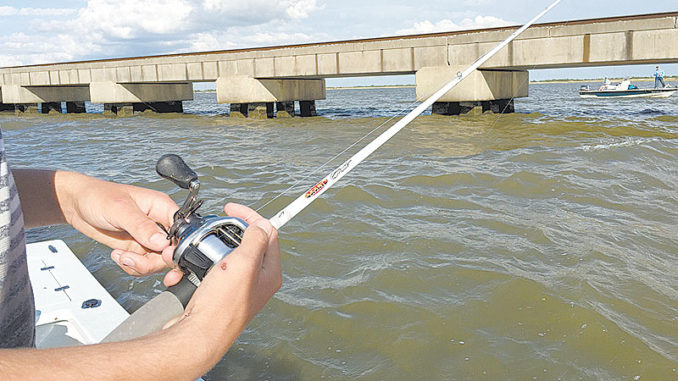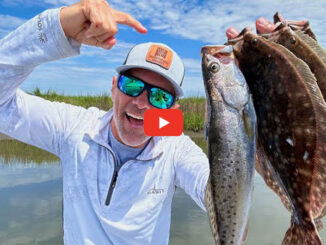
Keep thumb or index finger in contact with line when lure is falling, Champagne says
When you’re deepwater jigging for speckled trout in a challenging place like Lake Pontchartrain — or really anywhere where you’re fishing in more than about 6 feet of water — you need to use every advantage at your disposal to feel the bite.
That’s why several noted Lake Pontchartrain trout anglers — including Matrix Shad owner Chas Champagne — palm their baitcasting reels and keep their index finger or thumb in constant contact with the line when their lure is falling through the strike zone to help them detect subtle bites.
“There’s a reason fishing the bridges is complicated,” Champagne said. “It’s not only that it’s deep, but you also have current lines and waves. So feeling the bite while you’re fishing a foot-and-a-half tide range —which means the current is moving at about 1 knot, with a foot-and-a-half chop on top of that — can be tricky.”
With the wind blowing, the boat rocking and the current ripping, detecting a subtle bite and even feeling the bottom with a ⅜-ounce jighead can be difficult — at best. But Champagne says maintaining physical contact with the line — especially as the lure is falling — is crucial.
“A lot of your strikes happen when the lure is swimming back down. Especially with the Matrix Shad, the gravity of the jighead gives it a natural swimming motion. It’s making that tail flutter,” he said. “So the fish will attack it when it’s falling and you won’t even know it.
“You need to watch your line and feel your line. If it’s slick calm and the tide isn’t moving that much, anybody can detect a strike. But especially when the wind’s blowing the opposite direction of the tide, that is some tricky stuff when that happens.”
The right timing
You don’t have to feel the line when you’re reeling in slack or jigging, Champagne said.
“But when it’s free-falling you need to hurry up and slip your finger under there. That way, if it’s falling and they hit it, you’ll feel it in your finger,” he said. “After you pop it real erratically, you hurry up and reel in your slack where you have a little bit of tension, and you allow it to fall back to the bottom again.
“Every time we pop that lure, I’d say it’s a good two or three count before it settles back to the bottom again. During that two or three count, that’s when you put your finger on that line.”
But palming the reel typically leaves only three fingers supporting the rod — your middle finger, ring finger and pinky — and with your index finger above the rod, Champagne said you have to remember you have lots less hook-setting power.
“We don’t use the trigger on our rods,” he said. “We’re all the way past it when we’re deepwater jigging. The higher on the rod you are, the more you’re going to feel.
“That’s just simple physics. The further the vibration has to go, the less you’re going to feel.”
The magical amount of slack
In combination with maintaining finger contact with the line, Champagne suggests keeping a close eye on the 3 feet of bowed line extending from the tip of your rod. If it straightens out or jumps, you’ve got a bite.
“You want to have that magical amount of slack,” he said. “If you reel it in too tight, you’re going to pull the lure toward the boat. But if you don’t reel in enough slack, you’re never going to feel the little tick.
“So after you pop it — pop, pop, pop — you’re going to crank it two or three times to get just enough tension to where you’re not pulling the lure back to you, but you can still feel it if a fish hits it on the fall. The perfect amount of slack is key.”


